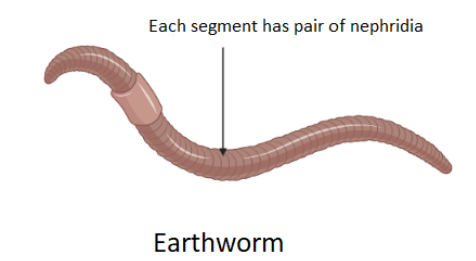
Which of the following nephridia is not found in earthworm?
A. Septal nephridia
B. Macro nephridia
C. Integumentary nephridia
D. Pharyngeal nephridia
Answer
411.4k+ views
Hint: A terrestrial invertebrate which belongs to the order opisthopora is called an earthworm. Coiled tubular duct-like organs that regulate the function of filtering and removing waste out of the body is called nephridia. Three types of nephridia are present in earthworm and are named based on the location it is found in the earthworm.
Complete answer: An earthworm is a terrestrial animal whose body plan is like a tube within a tube and externally it shows the presence of segmentation corresponding to the internal segmentation. An organ called nephridia is a tube coiled like structure that performs the function of filtering waste out of the body. They are mainly grouped in pairs and are present throughout the body. Three types of nephridia are seen on the earthworm’s body. Depending upon the location it is situated they are named pharyngeal nephridia, integumentary nephridia, and septal nephridia. Large numbers of smaller nephridia are grouped into three sets of tusks called pharyngeal nephridia. Filtering nitrogen from the clusters of surrounding capillaries is done by pharyngeal nephridia. The nephridia located on both sides of septa are called septal nephridia. Maintenance of water regulation and osmoregulation in earthworm is done by the septal earthworm. Integumentary nephridia are located throughout the body of the earthworm and help in the exchange of nitrogen from the body to the soil.

So, option B is the correct answer.
Note: Nephridia is a part of the excretory system of earthworm. Nephridia is present in all segments of the earthworm but is absent in the starting first segments and last one segment. However, the respiration system in earthworms does not have special organs to perform respiration. Therefore, the exchange of gases takes place through moist skin and capillaries.
Complete answer: An earthworm is a terrestrial animal whose body plan is like a tube within a tube and externally it shows the presence of segmentation corresponding to the internal segmentation. An organ called nephridia is a tube coiled like structure that performs the function of filtering waste out of the body. They are mainly grouped in pairs and are present throughout the body. Three types of nephridia are seen on the earthworm’s body. Depending upon the location it is situated they are named pharyngeal nephridia, integumentary nephridia, and septal nephridia. Large numbers of smaller nephridia are grouped into three sets of tusks called pharyngeal nephridia. Filtering nitrogen from the clusters of surrounding capillaries is done by pharyngeal nephridia. The nephridia located on both sides of septa are called septal nephridia. Maintenance of water regulation and osmoregulation in earthworm is done by the septal earthworm. Integumentary nephridia are located throughout the body of the earthworm and help in the exchange of nitrogen from the body to the soil.

So, option B is the correct answer.
Note: Nephridia is a part of the excretory system of earthworm. Nephridia is present in all segments of the earthworm but is absent in the starting first segments and last one segment. However, the respiration system in earthworms does not have special organs to perform respiration. Therefore, the exchange of gases takes place through moist skin and capillaries.
Recently Updated Pages
Master Class 11 Accountancy: Engaging Questions & Answers for Success

Express the following as a fraction and simplify a class 7 maths CBSE

The length and width of a rectangle are in ratio of class 7 maths CBSE

The ratio of the income to the expenditure of a family class 7 maths CBSE

How do you write 025 million in scientific notatio class 7 maths CBSE

How do you convert 295 meters per second to kilometers class 7 maths CBSE

Trending doubts
10 examples of friction in our daily life

One Metric ton is equal to kg A 10000 B 1000 C 100 class 11 physics CBSE

Difference Between Prokaryotic Cells and Eukaryotic Cells

State and prove Bernoullis theorem class 11 physics CBSE

What organs are located on the left side of your body class 11 biology CBSE

Write down 5 differences between Ntype and Ptype s class 11 physics CBSE




